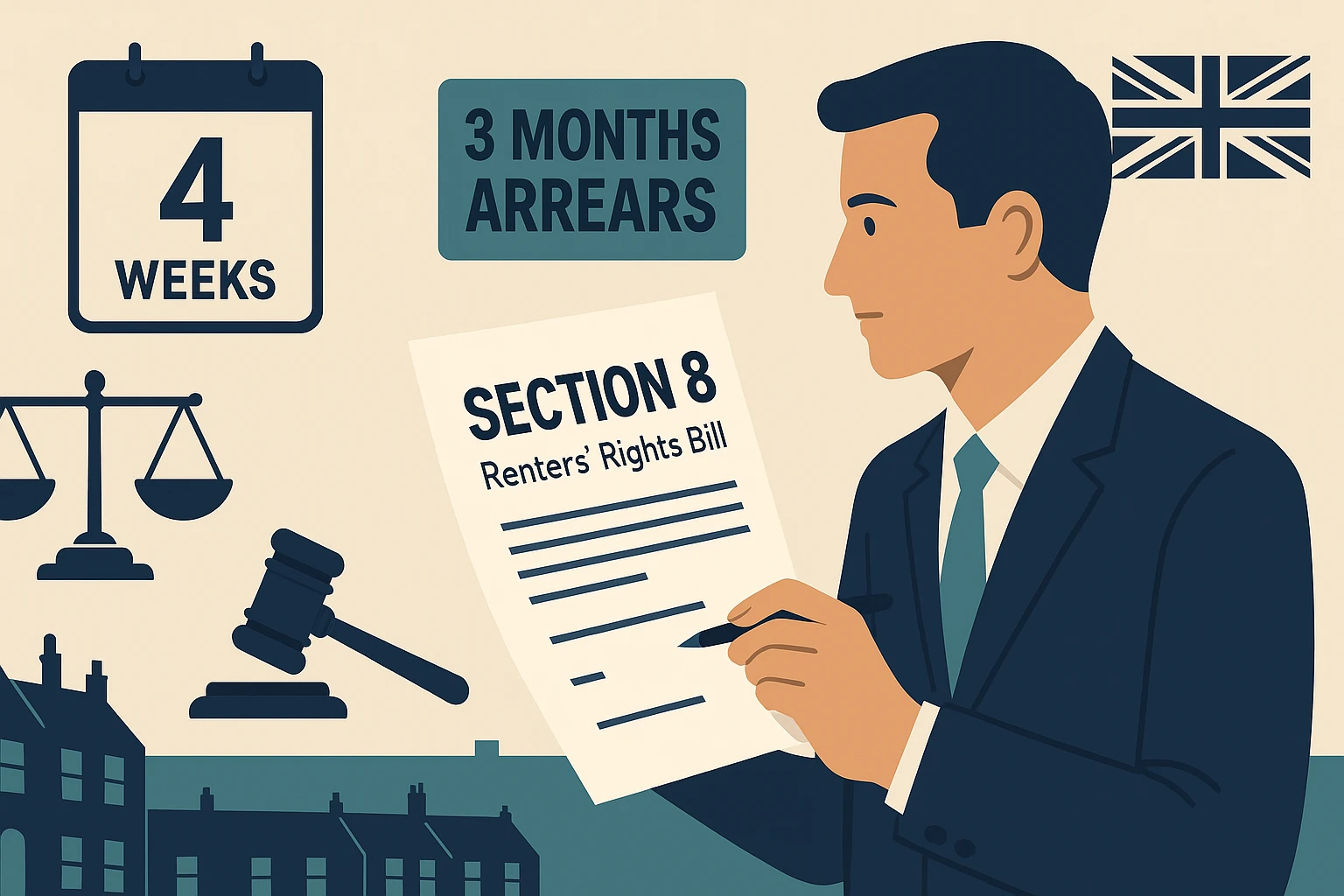Section 21 is set to go. Under the Renters’ Rights Bill, landlords will rely far more on Section 8 – with longer notice periods and a higher “serious arrears” threshold on the way. This step-by-step playbook shows how to secure possession swiftly and lawfully.
Quick status (October 2025)
- The government intends a one-stage switch-over for the private rented sector on a single commencement date (with notice), converting existing ASTs and applying the new rules to new tenancies the same day. Always check what’s actually in force before you act.
- Section 21 will be abolished; most tenancies move to periodic as standard.
- Arrears changes headline: 4-week notice for arrears grounds and Ground 8 at 3 months’ arrears (or 13 weeks if rent is weekly/fortnightly), with protection where arrears exist solely due to a confirmed Universal Credit payment that hasn’t yet landed.
Bottom line: plan for the new thresholds and timelines now- but serve current notices using the in-force rules until commencement.
Why Section 8 prep matters more than ever
With S21 going, the cleanest arrears route will be Ground 8 (serious arrears), usually pleaded with Grounds 10 & 11. The higher threshold and longer notice mean borderline balances and paperwork slips will bite harder. Preparation – not argument wins these cases.
The anatomy of a winning arrears claim
1) Get the paperwork perfect
- Tenancy file: executed AST, deposit protection + prescribed information, EPC, gas safety, EICR, “How to Rent” (where applicable), Right-to-Rent checks, and any licensing evidence.
- Rent ledger: one continuous ledger from day 1 to today (no fragments).
- Pre-action conduct: polite chasers, a neutral arrears statement, and any reasonable repayment proposals you offered.
- Vulnerability notes: record benefits delays/health issues and the help you signposted—this shows reasonableness.
2) Serve notices that stick
- Grounds: for arrears, plead 8, 10, 11 together; add conduct grounds only with solid evidence.
- Service: follow the AST’s service clause; if in doubt, use two methods (e.g., post + email) and keep proof.
- Arithmetic: state arrears precisely at service and note they continue to accrue.
3) Evidence judges actually use
A short, factual witness statement from the landlord/agent: tenancy start, rent terms, arrears chronology, steps you took to resolve, and the current balance with the ledger exhibited. Keep argument out – let the documents do the talking.
Your first 30 days: a simple playbook
Days 1–7
- Friendly reminder with exact balance + payment options.
- Offer one realistic plan (weekly/fortnightly). Log vulnerabilities/benefit issues.
Days 8–14
- Second chaser + formal arrears statement. Invite a written plan within 72 hours.
- If you take part-payment, acknowledge without waiving rights.
Days 15–21
- Pre-action letter: balance, timeline, your attempts to resolve, and notice that a Section 8 will follow absent a plan/payment.
Days 22–30
- Serve Section 8 (Grounds 8, 10, 11). Diary the expiry.
- If a credible plan appears and is kept, you can pause issue; if not, issue the claim the day after expiry.
Tip: diary three dates at service: (i) notice expiry, (ii) last safe issue date (to avoid Ground 8 being undermined by a balance dip), and (iii) a review date to choose bailiff vs HCEO post-order.
Court strategy that saves time
- Issue promptly after expiry – drift lets balances dip under Ground 8’s mandatory threshold.
- Bundle smart: claim form, AST, compliance docs, ledger, notice + proof of service, short witness statement.
- Enforcement: County Court bailiff can be slow; transfer up to High Court (HCEO) may be proportionate where delay risks loss or deterioration – take advice early.
What changes under the Bill (at a glance)
- S21 abolished; periodic tenancies as standard.
- Arrears notice periods: 4 weeks (up from 2) for Grounds 8, 10, 11.
- Ground 8 threshold: 3 months’ arrears (13 weeks if weekly/fortnightly), met at service and at hearing; UC waiting-payment protection applies.
- Rent increases: Section 13 only (no rent-review clauses), 2 months’ notice, Tribunal jurisdiction to assess market rent and no backdating; Tribunal cannot set a rent above the landlord’s ask.
- “Landlord use” grounds (sell/move-in): available with evidence and not in the first 12 months of a new tenancy.
Action checklist for landlords
- Keep a single rent ledger per tenancy; reconcile monthly without gaps.
- Standardise a pre-action pack (two chasers + arrears statement + repayment offer).
- Create a witness statement skeleton and bundle index you can reuse.
- For “sell/move-in” cases, collect intention evidence (marketing instructions, purchase timelines, family declarations) and note the 12-month bar on using those grounds in a new tenancy.
- Track commencement dates on GOV.UK or a reliable tracker before serving any notice.
FAQs
Can I still serve Section 21 now?
Yes – until the new law starts. Check the current status before acting.
What notice will I give for arrears after commencement?
Four weeks for Grounds 8, 10, 11.
How much is “serious arrears” for Ground 8?
Three months’ arrears (or 13 weeks if rent is weekly/fortnightly), which must be met at service and at hearing; there’s protection where arrears exist only due to a pending UC payment.
When will all this actually bite?
The PRS is expected to move on a single switch-over date (with notice). Verify the date before serving any notice.
Need a Section 8 claim that sticks?
Send us your tenancy files today. We’ll flag any compliance gaps and map the fastest lawful route from notice → issue → hearing → enforcement.


